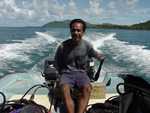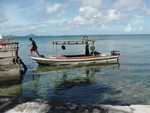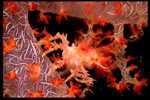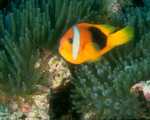| |

This morning Karen and I awoke to a tropical downpour. The rain lasted all morning and even as we pulled away from the dock on our way to dive it was still raining hard. Luckily, we did manage to get some great diving in today. I'm going to tell you about diving on the Sinkisan Maru and the Betty Bomber. Then I will share with you what I know about reefs and about the marine life that lives in Chuuk Lagoon.
Sinkisan Maru
(Click on any photo to enlarge it.)
 Estos, our boat captain, announced that he would be taking us to the Sankisan Maru for our first dive of the day. Today my mission was to record as many different kinds of marine life as I could identify. Armed with my underwater slate and pencil, I dropped off the edge of the boat into the clearest water of our trip. At 65 feet I reached the deck of the Sankisan Maru and had at least 100 feet of visibility. Karen reached the bottom right behind me and we were off on our
scavenger hunt.
Estos, our boat captain, announced that he would be taking us to the Sankisan Maru for our first dive of the day. Today my mission was to record as many different kinds of marine life as I could identify. Armed with my underwater slate and pencil, I dropped off the edge of the boat into the clearest water of our trip. At 65 feet I reached the deck of the Sankisan Maru and had at least 100 feet of visibility. Karen reached the bottom right behind me and we were off on our
scavenger hunt.
As we swam along the deck of this Japanese transport ship, I immediately started to record the fish. I must admit that, being from Colorado, fish and coral identification in the South Pacific Ocean is not one of my strongest points. At the end of my journal today I will copy the list I made on this dive. Try to look up these fish in your school library to see what they look like and to make sure they actually live in the South Pacific region.
The Sankisan Maru sank after suffering a bomb blow in its stern (back) area. The hit apparently struck one of the aft holds that was full of ordinance (bombs) and the entire stern was blown apart.
After a quick survey of the mangled wreckage (really all that is left of the stern area) Karen and I headed toward the bow. Dropping down into hold #1, we noticed that the entire floor was covered with thousands, no, millions of bullets. Bullets were everywhere. Some of them were still in their original wooden crates.
A large hole in the wall of hold #1 allowed us to swim directly into hold #2 where we found several truck frames complete with steering wheels and tires. In the back area of the storage hold, my light illuminated an airplane engine and numerous empty bottles that once contained beer and medicine.
Swimming back along the deck of the ship, we located several more trucks complete with tires, steering wheels, radiators, drive trains, and engines. It is my understanding that these Japanese army trucks were made by Toyota and Isuzu. After having a close look at the trucks, we realized we were both low on time and air, and so we started our slow ascent back to the surface.
Betty Bomber
 After a two-hour rest to allow the nitrogen levels in our bodies to decrease, we headed off to a very different type of wreck. This dive was on a Betty Bomber plane. "Betty" was the code name given by the Americans for the Japanese Mitsubishi G4M bomber, a twin-engine tactical plane that could be used for torpedo attacks as well. It was a very successful aircraft early in the Second World War for Japan and was later nicknamed the "Flying Cigar" because it resembled a cigar.
After a two-hour rest to allow the nitrogen levels in our bodies to decrease, we headed off to a very different type of wreck. This dive was on a Betty Bomber plane. "Betty" was the code name given by the Americans for the Japanese Mitsubishi G4M bomber, a twin-engine tactical plane that could be used for torpedo attacks as well. It was a very successful aircraft early in the Second World War for Japan and was later nicknamed the "Flying Cigar" because it resembled a cigar.
It seems that the plane suffered damage during the American attack and crashed into the lagoon while trying to land on the island of Eten. It was quite a thrilling sight to see, this almost completely intact bomber displayed on the ocean bottom. Swimming up close I noticed that hardly anything was left of the nose except bent and twisted window framing.
The hole where the nose used to be was large enough for me to fit into, so I entered the plane and was able to swim through and squeeze out the rear tail area. Both engines were ripped off the wings when the plane hit the water, but we were able to locate them a short distance from the bomber's body.
Once again I continued to record both fish and coral as I swam around the Betty and added a few new species to my list before heading back up to the dive boat.
The sunken fleet of Chuuk (Truk) Lagoon represents the world's largest collection of artificial reefs. Relentlessly, marine life has found a home in these sunken Japanese ships.
Artificial Reefs
Although the reefs of Chuuk Lagoon are called "artificial" (because coral builds on the sunken ships), there is nothing artificial about them.
Soft Coral Crab

The world of the coral reef is one of the most diverse ecosystems on our planet, rivaling even that of the tropical rain forest. Built over thousands of years by tiny calcium-producing organisms, reefs are havens for countless life forms, some of which may seem totally alien. It is a fairy tale world of bright colors and ever changing patterns. Only on the reef can one find living examples from nearly every group of organisms representing a billion years of evolution.
Coral reefs cover about 0.2 percent of the ocean floor. Even though they cover such a small area, scientists estimate that coral reefs contain approximately 25 percent of the ocean's species. Almost 5,000 species of reef fish have been identified, and more than 2,500 species of coral. Did you know that the calcium carbonate from the sand, shells, and coral maintains the pH balance in the ocean, which in turn maintains life as we know it?
The Reef Education Network
(www.reef.edu.au) had some interesting information about what coral reefs do for us:
- provide shorelines with protection by breaking waves
- serve as nurseries for growing fish
- supply a protein source for coastal people's diets
- give food, shelter, and protection to a variety of marine species
- provide fishing and tourism jobs
- supply materials for medicines against a variety of illnesses
- give us a magnificent underwater world to study and enjoy
Marine Life
 Because of the way ocean currents meet around the Micronesian islands, this area is home to an enormous variety of marine life such as angelfish, bonito, butterfly fish, eels, grouper, harp fish, jacks, mahi-mahi (also called dolphin, though not the mammal), mullet, parrot fish, stingrays, tuna, and more. Marine animals that could cause trouble for divers, but rarely do include sharks, barracudas, sea urchins, jellyfish, stonefish, crown-of-thorns starfish, cone shells, and eels.
Because of the way ocean currents meet around the Micronesian islands, this area is home to an enormous variety of marine life such as angelfish, bonito, butterfly fish, eels, grouper, harp fish, jacks, mahi-mahi (also called dolphin, though not the mammal), mullet, parrot fish, stingrays, tuna, and more. Marine animals that could cause trouble for divers, but rarely do include sharks, barracudas, sea urchins, jellyfish, stonefish, crown-of-thorns starfish, cone shells, and eels.
In addition to fish, the waters around the FSM nurse other types of marine life. There are a lot of hard and soft corals, along with anemones, sponges, sea cucumbers, and shellfish like the giant tridacna clam. Sea turtles such as hawksbills, green turtles, or leatherbacks lounge on reef beaches. Some Micronesians like to eat turtles and their eggs, but because these animals are on the endangered species list practice is illegal.
If you want to see some incredible photos of the types of marine life you can see in Chuuk, check out this link.
www.hunterpix.com/Pages/uwpacif.html
The link below has some great photos of different types of coral and all kinds of info on coral reefs.
www.marinebiology.org/
As I told you, on our dives, Karen and I tried to come up with our own list of fish species and marine life. Try to look up some of the different organisms I have listed below. Send me an email if I have identified one that doesn't belong in the South Pacific.
Fish
blue damselfish
jellyfish
puffer fish
lion fish
banner fish
barracuda
clown fish
red squirrel fish
fourline snapper
spangled emperor
blackface rabbitfish
bluegreen chrome
manyspot sweetlips
stipey snapper
goldenline rabbitfish |
Plants, Coral, and Other Sea Life
anemone
oysters
sponge
tube coral
alcyonarian coral
bubble coral
sea squirts
plumed hydroids
brown alga
table top coral
stag horn coral |
Our last day to dive is tomorrow. Make sure you check out my journal then to hear about the final Chuuk Lagoon scuba adventure.
Tom
|


